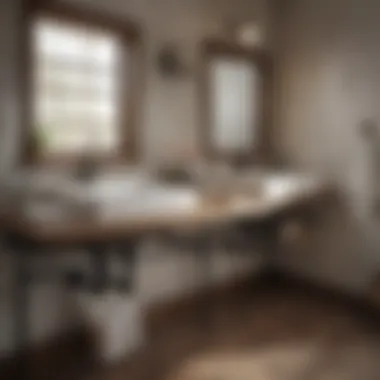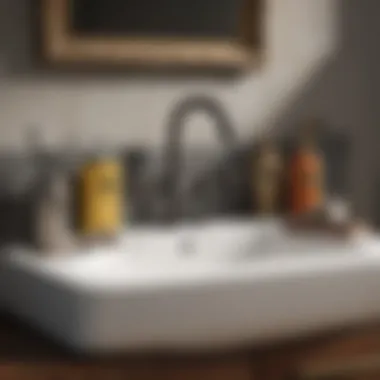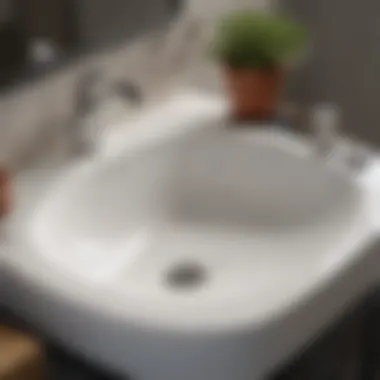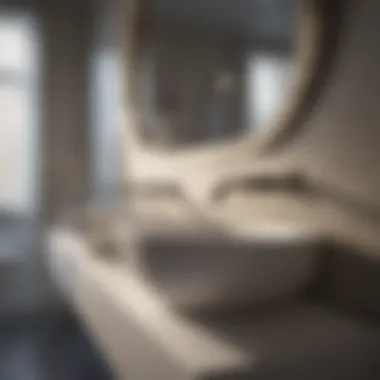Effective Solutions for a Double Bathroom Sink Clog


Intro
Dealing with a double bathroom sink that is clogged on both sides can be frustrating. This situation often denotes underlying plumbing issues that demand attention. Understanding the root causes is essential in tackling this problem effectively. Homeowners who face this need practical solutions and guidance.
In this comprehensive guide, our focus will be on identifying the reasons behind such clogs. We will explore various methods for diagnosis and effective interventions. Whether you prefer do-it-yourself approaches or considering professional help, we aim to equip you with the necessary knowledge. Awareness of preventative measures will also be underlined throughout this article, ultimately enhancing the functionality of your bathroom.
Foreword to Double Bathroom Sinks
Double bathroom sinks are a popular feature in many households. They provide convenience and enhance functionality in shared spaces, particularly during busy mornings when more than one person needs to use the sink. The dual setup allows for simultaneous use, thus minimizing wait time. Additionally, double sinks can elevate a bathroom's aesthetic appeal. They often serve as a focal point in the design, making a statement of style and modernity.
Understanding the nuances of double sink configurations is essential. It allows homeowners to appreciate the benefits and potential challenges associated with their plumbing systems. Failing to recognize these factors can lead to issues, such as clogged drains, that disrupt daily routines and require intervention. This article seeks to offer insights into resolving common plumbing problems related to double sinks, emphasizing clarity and methodical approaches.
Identifying Clogs in Double Sinks
Identifying clogs in double sinks is a crucial step toward resolving plumbing issues effectively. A clear understanding of signs and potential causes allows homeowners to diagnose problems early. This knowledge can save time and reduce frustration in addressing plumbing issues. Both sides of a double sink can become clogged due to shared drainage paths, making it imperative to determine the specific nature of the clog for targeted actions.
Signs of a Clogged Sink
Recognizing the signs of a clogged double sink is essential. The following indicators commonly suggest a blockage:
- Slow draining: Water pooling in both sinks during use is a clear warning.
- Gurgling sounds: If air is trapped in the drain, gurgling noises may emerge when the sinks are in use.
- Unpleasant odors: Foul smells can indicate stagnant water or decaying material within the pipes.
- Water backing up: Water from one sink overflowing into the other indicates a significant issue with the plumbing system.
Noticing these signs promptly can lead to quicker resolutions and may help prevent severe plumbing issues down the line.
Potential Causes of a Complete Clog
Understanding the potential causes of a complete clog can guide effective troubleshooting. Common issues include:
- Hair and debris: Hair can easily accumulate in the sink trap over time, combined with soap and other debris.
- Grease buildup: Kitchen waste and greasy products can solidify in the drain, leading to a blockage.
- Foreign objects: Items like toothbrushes or small toys can find their way into the drain.
- Hard water deposits: Mineral buildup from hard water can restrict flow within pipes.
Every home is different, but these factors frequently contribute to more serious blockages. Looking deeper into these causes can assist in choosing the right unclogging method.
"Early detection of clogs can prevent extensive plumbing repairs and ensure a functional home environment."
Identifying clogs in double sinks is vital for maintaining the home’s plumbing system. Through careful monitoring and understanding of the underlying causes, homeowners can effectively manage and resolve these common issues.
Initial Troubleshooting Steps
Understanding how to troubleshoot a clogged double bathroom sink is essential for effective home maintenance. When both sides of the sink are not draining properly, the issue can be more complex than a single-clog scenario. Starting with systematic troubleshooting can save time and effort later. Addressing the problem early can prevent further damage and prolong the lifespan of your plumbing. Homeowners can often resolve such issues without needing to call in professionals, provided they approach the situation with a structured mindset.
User-Level Diagnosis


Before attempting to dislodge any potential blockages, it is vital to assess the situation. Take note of the symptoms your sink is exhibiting. One common indicator is slow drainage or pooling water in both sinks while they are in use. This may hint at a larger issue than just food debris or hair causing the blockage.
To begin your diagnosis:
- Check for Gurgling Sounds: If there is a gurgling noise when water is draining, this usually indicates a vent issue or a partial blockage within the drain lines.
- Observe Water Flow: Pour water down each side to see if there is any difference in drainage time. This might narrow down which side has a more severe obstruction.
- Look Under the Sink: Inspect the plumbing under the sink. Look for any visible leaks or damages to the pipes. If you notice any signs of rust or corrosion, it could suggest a more significant plumbing issue.
- Listening for Draining: While one sink drains, the other should not backup. If it does, you might be dealing with a shared pipe issue.
Carrying out these preliminary checks can help form a clearer picture of the problem, setting you up for successful unclogging efforts.
Unclogging Methods for Homeowners
Once you have identified the potential causes of the clog, you can select from various methods to address the issue. Here are some practical techniques every homeowner should consider:
- Plunger Usage: A good old plunger can be quite effective. Ensure that both sinks are filled with some water, and create a seal with the plunger over the drain. Push down and pull up quickly. Repeat this several times to dislodge any blockage.
- Baking Soda and Vinegar: A natural alternative is using baking soda and vinegar. Pour half a cup of baking soda into the drain, followed by half a cup of vinegar. Let it sit for around 30 minutes, then flush with hot water. This combination can help break down minor clogs.
- Wet/Dry Vacuum: If you have access to a wet/dry vacuum, this tool can be utilized to suck out the obstruction. Ensure you create a tight seal around the drain with the vacuum attachment.
- Plumbing Snake: If the clog persists, a plumbing snake can be employed. Feed the snake into the drain until you feel resistance. Turn the handle of the snake to break apart the clog or pull it out.
By following these methods, homeowners can resolve many clogging issues without professional help. However, knowing when to stop and consult a plumber is crucial if problems persist or worsen.
Tools and Materials Needed
Addressing a clogged double bathroom sink necessitates the right tools and materials. Having these items on hand ensures that the process is less time-consuming and more efficient. Without proper tools, one may struggle to effectively deal with the clog. Thus, preparation can significantly ease the repair efforts and help to prevent potential damage to plumbing.
Essential Plumbing Tools
A variety of plumbing tools can aid in unclogging tasks. Below is a list of essential tools:
- Plunger: A common tool used to create suction, helping dislodge clogs. Ensure it is specifically designed for sinks.
- Pipe Wrench: This tool grips and helps loosen pipes to allow for necessary inspection and removal of blockages.
- Basin Wrench: Especially useful for accessing hard-to-reach nuts while attempting to remove the sink trap.
- Plumbing Snake: Effective for reaching symptoms further down the drain that a plunger cannot reach.
- Bucket: This will catch drips and spills when traps or pipes are removed.
- Gloves: Protect your hands from debris, chemical cleaners, or other unpleasant materials during unclogging.
Having these tools readily available can help prevent frustration and delays during the unclogging process. Each tool plays a specific role in effectively tackling the blockage.
Cleaning Supplies for Effective Maintenance
Cleaning supplies are equally important for preventative care after resolving a clog. Keeping the area clean prolongs the life of your plumbing system. Some recommended supplies include:
- Bio-Enzymatic Drain Cleaner: These cleaners utilize enzymes to break down organic matter that may lead to clogs without harming pipes.
- Disinfectant Cleaner: Helps in maintaining overall cleanliness around the sink area, reducing debris accumulation in the long run.
- Baking Soda and Vinegar: This natural mixture is an effective way to keep drains fresh and help manage minor buildup before it becomes a serious problem.
Incorporating these cleaning supplies not only aids immediate concerns regarding clogs but also fosters a clean environment that can help prevent future issues.
Key Consideration: Using the right tools and cleaning supplies is crucial not only for addressing current problems but also for maintaining plumbing health. Regular upkeep mitigates issues and extends the durability of systems in place.
Step-by-Step Unclogging Process
Addressing a clogged double sink can be challenging. A systematic approach is essential for effective resolution. This section aims to outline a step-by-step unclogging process to help you navigate the situation effectively.


Removing the Sink Trap
First, you need to locate and remove the sink trap. This component is a curved pipe located underneath the sink. Removing it allows access to the blockage. Start by placing a bucket beneath the trap to catch any water or debris. Use a wrench to loosen the slip nuts connecting the trap. After detaching it, inspect the trap for hair, soap residue, or other obstructions. Clean out any debris found, then reassemble it carefully. This step is crucial because many clogs accumulate in the trap itself.
Using a Plunger Successfully
A plunger can be an invaluable tool when dealing with a clogged double sink. Before using one, ensure there is enough water in the basin to create a seal around the plunger. Position the plunger over the drain and push down firmly to create suction. Pull up sharply to release any blockages. Repeat this action several times for best results. It's important to cover the other drain with a wet cloth to enhance suction in the targeted drain. This technique often helps to dislodge the clog without needing further tools.
Chemical Drain Cleaners: Pros and Cons
Chemical drain cleaners present a quick fix for stubborn clogs. However, it is vital to be cautious with their use.
Pros
- Immediate Results: Many formulas work quickly to dissolve blockages.
- Easy to Use: Just pour the solution down the drain and wait.
- Chemical Composition: Strong chemicals can tackle tough debris.
Cons
- Potential Damage: Harsh chemicals can corrode pipes over time.
- Environmental Concerns: Many products contain toxic substances.
- Temporary Solution: They often do not address underlying issues.
Considering these points, it is advised to use them sparingly and as a last resort.
Utilizing a Plumbing Snake
If previous methods fail, using a plumbing snake can be effective. A snake, or auger, is designed to reach deeper into the pipe to clear blockages. Insert the snake into the drain and turn the handle clockwise. This action allows the coil to navigate through plumbing. Once resistance is met, continue turning the handle to either break the clog or hook it. Pull the snake out carefully, clearing the debris as it emerges.
Employing this tool can prevent more severe plumbing issues by ensuring thorough cleaning of pipes.
By following these outlined steps meticulously, you can effectively resolve a double sink clog and ensure smooth drainage moving forward.
Preventative Measures
Preventative measures are essential when it comes to maintaining the functionality of double bathroom sinks. Regular checks and small interventions can save a homeowner from significant plumbing troubles in the future. A clogged double sink can lead to frustration, unsanitary conditions, and costly repairs. Thus, understanding how to avoid such situations is key for effective home management.
Regular Maintenance Tips
Regular maintenance is the cornerstone of effective plumbing care. A few simple habits can go a long way in preventing clogs:
- Routine Cleaning: Clear out any debris that might accumulate in the drain area. Hair, soap residue, and other materials can build up over time.
- Use a Drain Strainer: Prevent hair and large particles from entering the drain by using a strainer. This tool can capture debris while allowing water to flow freely.
- Flushing with Hot Water: Periodically run hot water down the sink. This practice helps dissolve buildup and keeps pipes clear. You can mix in a bit of vinegar for added effectiveness.
- Baking Soda and Vinegar: Employ this natural solution once a month. Pour half a cup of baking soda followed by half a cup of vinegar into the drain. Let it sit for 15 minutes, then flush it with hot water.
Regular maintenance can considerably reduce the chances of faced plumbing issues in the future.


Optimal Practices for Users
After understanding the importance of maintenance, it’s crucial to implement optimal practices while using the sinks. This can help maintain their functionality:
- Avoid Chemical Drain Cleaners: While tempting, frequent use can damage pipes over time. Natural methods are safer and just as effective.
- Mindful Disposal: Do not rinse food particles, grease, or any inappropriate materials down the sink. This simple change can significantly reduce blockage risks.
- Educate Household Members: Ensure everyone in the household knows the proper usage of the sinks. Establish rules for what can and can't go down the sink.
- Regular Inspections: Keep an eye on the condition of the plumbing. If something seems off, address it before it turns into a bigger issue.
By incorporating these strategies, homeowners can effectively protect their plumbing systems. A proactive approach allows for smoother functionality and less stress when it comes to managing a double bathroom sink.
When to Seek Professional Help
Sometimes, despite our best efforts, a double bathroom sink can remain stubbornly clogged. This can be frustrating and, at times, overwhelming. Knowing when to seek professional help is crucial. Professionals can provide expertise that goes beyond simple unclogging methods. They diagnose underlying issues that may not be evident to the average homeowner. This knowledge can prevent recurring problems and save time and potential damage.
When faced with persistent clogs, consider the following elements:
- Complexity of the Issue: If the clog is consistently returning, it may indicate a deeper issue within your plumbing system. Issues like tree roots invading pipes or broken pipes require specialized intervention.
- Time Constraints: Not everyone has the time or the desire to delve into complex plumbing problems. If you find it difficult to spend time on diagnostic processes or cleanup, contacting a professional may be more viable.
- Safety Concerns: Some plumbing tasks pose risks, particularly if hazardous chemicals or tools are involved. When in doubt, it’s better to let a qualified plumber handle the situation.
In short, understanding when to engage a professional can save you from unhygienic conditions and worsening plumbing issues. Visiting sites like reddit.com can provide insights from those who have faced similar situations regarding when to call for help.
Identifying Serious Issues
It's critical to recognize when plumbing problems indicate a serious issue. Keep an eye out for:
- Multiple Drains Sluggish: If both sinks and perhaps other drains are slow, this could signal a main sewer line blockage.
- Foul Odors: Persistent bad smells emanating from the drains may suggest waste buildup or a blockage.
- Gurgling Sounds: Hearing gurgling noises can indicate trapped air and signify a more significant clog.
- Water Backflow: If water begins to backflow, or if it ends up in unintended areas, this can point to a serious plumbing failure.
If you notice these signs, consider professional help immediately. Ignoring them could lead to costly damages in the future.
Choosing the Right Plumbing Service
When choosing a plumbing service, it’s essential to consider both reputation and qualifications. Look for:
- Licensing and Insurance: Verify that the plumber is licensed in your area and carries insurance to protect against damages during work.
- Experience and Specialization: Opt for plumbers who specialize in residential plumbing and have substantial experience with double sink systems.
- Reviews and References: Read online reviews on platforms like facebook.com or forums to gather insights about their service quality.
- Estimates: A good plumbing service should provide a written estimate that details costs before starting the work. This transparency can prevent unexpected charges.
Engaging a professional plumbing service can ultimately afford you peace of mind. It ensures that the problem is solved right the first time, often leading to a more durable solution than DIY attempts.
End
Addressing the issue of a double bathroom sink clogged on both sides is crucial for maintaining both functionality and hygiene in your home. This article covers various aspects necessary for effectively resolving such plumbing problems. Understanding the main causes of clogs is the first step. An informed homeowner can often make the right decisions regarding necessary interventions and maintenance.
Summary of Key Points
- Identifying Clogs: Recognizing signs of a clog early can save time and money. Watch for slow drainage and unusual odors as initial indicators.
- Troubleshooting Steps: Implement user-level diagnosis techniques and utilize homeowner-friendly unclogging methods. This empowers you to act before contacting professionals.
- Tools and Materials: Having essential plumbing tools and cleaning supplies on hand can enhance your ability to handle minor issues effectively.
- Preventative Measures: Regular maintenance goes a long way in reducing the chances of clogs developing in the first place.
- When to Seek Help: Knowing when a problem exceeds home repair capabilities is essential for preventing major damage.
Final Thoughts on Maintenance and Care
Regular inspections and adopting good practices can prevent unexpected clogs. Simple habits like managing what goes down the sink, using screens to block debris, and cleaning out traps periodically contribute significantly to ongoing care. For homeowners, understanding their plumbing system allows for proactive measures that can mitigate complex issues.
Taking ownership of bathroom maintenance is an investment in your home’s value and functionality.
It is never too late to start integrating effective plumbing care routines into your household practices. This will not only save you time and money in the long run but also improve the overall experience of your bathroom usage.



